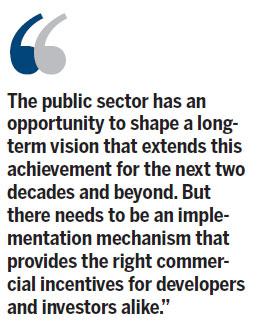Ensuring Hong Kong has a sustainable future
Updated: 2014-07-01 05:47
By Paul Walters(HK Edition)
|
|||||||
We read Raymond So's article in this section of China Daily ("No Easy Solutions to SAR's Housing Problems", June 19) with interest. In it, he accurately outlines the highly complex problem of meeting demand for public housing. Apart from the stark challenge of supply and demand, there are other issues that make the situation even more complex.
These issues were laid out clearly in the Hong Kong government's last budget speech: expanding urban areas to cater for the projected increase in population, an aging population and the need to focus on environmental quality. We have looked carefully into these three issues in "Real Estate 2020: Building the Future" - a research paper examining the major global trends that will affect the real estate sector in Hong Kong and elsewhere. These three issues represent essential "building blocks" for creating a more sustainable, diverse and space-efficient Hong Kong. However, achieving these objectives will require the continued cooperation between public and private enterprises, that has helped Hong Kong become a vital node of global finance and commerce.
According to the 2011 census, the median age in Hong Kong had jumped to 41.7 from a youthful 26.3 over the previous 30 years. Hong Kong may seem ideal for the elderly: high-rise buildings without the need for stairs, and concentrated population centers within easy reach of healthcare and other amenities. But with many reaching the age where constant supervision is needed, we expect a huge rise in demand for specialist residencies for the elderly. We have seen this in other mature economies and expect the trend to continue in Hong Kong as the capacity for traditional family care diminishes, driven by population mobility and low birth rates, among other factors.
The budget included plans to build 210,000 public and private units on newly released land over five years. These projects continue a trend of establishing self-contained towns in the New Territories, with Tseung Kwan O (a relatively new city with capacity for 400,000 residents) being a prime example. One reason for this growing need is that the mainland is becoming less viable as a retirement destination, as property prices and the cost of living go up, while the RMB has (until a recent pause) gone from strength to strength. Hong Kong may need to host a higher proportion of its elderly than was previously thought to be the case.

Energy efficiency requirements are not stringent in Hong Kong, but some large domestic developers have acted on a voluntary basis to improve them. On the demand side, corporates and individuals are increasingly willing to pay a premium to lease sustainable buildings. On the supply side, developers and investors are weighing up the costs and benefits of going green. To encourage the uptake of more sustainable construction practices among developers, the government could provide additional incentives in the form of tax breaks for the development of environmentally friendly buildings or facilities.
Our report argues that there will be a greater need than ever for public and private sector collaboration in the development of real estate projects. We outline a range of factors, including the availability of capital in the private sector, the expertise of developers and the opportunity to mitigate risks in long-term projects.
In Hong Kong the government has a good track record of working with the private sector on structural planning. And new opportunities are arising for the public and private sectors to work together in the delivery of long-term community value. The potential redevelopment of prime land at Wah Fu stands as one such example. Built in the 1960s and 1970s for young families, the needs of residents back then were far different from the needs of its aging residents today.
One important way in which the government can start to address the challenges outlined in Mr So's article is by tapping into private capital via public private partnerships. The benefit of this is to reduce the fiscal burden on public finances while spreading the risks of such projects. In addition, a market-driven financing system also helps to broaden the range of projects that could potentially be developed.
The work of policymakers over the past two decades and more has helped shape Hong Kong into a leading regional cosmopolitan center. The public sector has an opportunity to shape a long-term vision that extends this achievement for the next two decades and beyond. But there needs to be an implementation mechanism that provides the right commercial incentives for developers and investors alike. Such a roadmap is in everyone's interests and will help the real estate sector build a Hong Kong in which we all wish to live, work and retire.
The author is a partner with PwC Asia Pacific Real Estate Assurance, and co-author Rachel Tsang is a partner with PwC Hong Kong Real Estate Assurance.
(HK Edition 07/01/2014 page9)